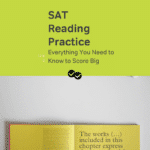A really difficult type of question on the SAT has you take a scenario discussed in the passage and choose which of five hypothetical scenarios it is closest to. As you probably guessed, these five hypothetical scenarios make up the five answer choices.
The passage below is already quite tricky, and the question below it trickier still. So I should warn you: only attempt this question if you are already consistently scoring around 600 on the Critical Reading section. Otherwise, don’t worry too much about this question type, as there may be only one or two such questions (and they are bound to be tough). Instead, spend your time on other questions in the critical reading section.
Today, the number of authors churning out novels is perhaps greater than at any time in history. That’s not so much because talent has flourished as there are simply more books being published today. Of course with so many recent novels claiming literary prizes, one would be inclined to believe that many works published today are instant classics. I’m not sure if this is the case—or indeed if anyone today is in the position to claim any recent book as worthy of the exalted tag: “Classic.” Part of the definition of a classic, after all, is that the work is still heralded decades after it was published. That the generation a few decades hence will perceive our present time as a golden age of literature is possible—though it may be too busy bestowing prizes on its own novelists.
The author’s reasoning (“That’s not . . . today”) is most analogous to which of the following?
(A) Since there are more professional baseball players today than at any time during the past, players’ salaries will continue to increase.
(B) Every year more people switch to electronic readers, thereby limiting the number of paperback books sold each year.
(C) Though the number of grizzly bears sighted in Yellowstone increases each year, so too have the number of visitors, a fact that suggests the number of bears has not increased.
(D) Scientists base the likelihood of a meteor impact based on the number of impact sites on the ground, a process that overlooks the fact that over two-thirds of the earth’s surface is water.
(E) Because most of the great pre-20th century artists came from humble backgrounds, the probability that an anonymous masterpiece is that of an aristocratic author is very low.
First off, we need to dissect the reasoning in the passage. The quoted line has a theory for why so many books are getting awards: there are simply more books published than before. In other words, more books equal more awards. It’s not that books today are actually better than books of previous generations.
What we are looking for in the correct answer is as follows: one thing looks like it is increasing (great books) but such an increase is actually because something more general is increasing (the total number of books).
Notice, how I made the reasoning more general, and just stuck the specifics in parenthesis. By doing so I can focus on the general logic without letting the specifics get too much in the way. Remember, we are looking for the answer choice that best “parallels” the reasoning from the passage on a general level. Indeed, a wrong answer choice will often contain the exact same subject—say, something about literature—to pull you in, though the general logic in that answer choice will be very different.
So let’s take a look at each of the answer choices.
(A), on the surface, seems to use similar reasoning: compare two different periods and in the second period something (players’ salaries) are increasing. But we need an answer in which something more general is increasing. Say (A) had been the total all baseball players were paid is increasing, because the total number of baseball players has increased. Then, (A) would be the answer.
(B) doesn’t parallel the reasoning in the passage since in (B) something specific increases because the general pool is increasing.
Now let’s take a look at (C). I’ll start by simplifying it—something you should also do with each answer choice.
More grizzly bear sightings seems like there are more grizzly bears in the park. But really there are just more people, and therefore the more people you have the more people there are to see a grizzly. So the number of sighting has increased because something more general (the total number of people) has increased. This mirrors the reasoning in the prompt.
(D) ignores a more general increase in anything. In fact, there doesn’t seem to be an increase in anything at all.
(E) doesn’t show a specific increase in something being part of a general increase. Sure the probability is higher that a random painting is from an artist from lowly economic background, but that doesn’t match the increase in one thing leading to an increase in another, the way as it is discussed in the passage.
If you are still with me, and haven’t lost your mind after sifting through all this verbiage, congratulations. But I think a quick recap is in store:
1. Skip parallel reasoning questions unless you are scoring above 600 on CR.
2. You can identify parallel reasoning questions because they come up with five random scenarios not at all mentioned in the passage.
3. Look for the general logic; do not be swayed by superficial similarities between the text and the answer choice.
As it appears in the passage, the word “heralded” most nearly means
(A) believable
(B) indistinguishable
(C) celebrated
(D) permissible
(E) announced






Leave a Reply